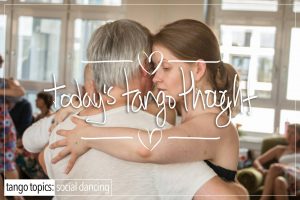At the beginning of our Tango lives, most people go to a Tango Class to learn how to dance Tango. Some people throw caution to the wind and just go to the Milonga and ‘learn’ on the dance floor, sometimes with positive results (few and far between), but most of the time with disastrous results. And some people take the route of skipping group classes altogether and start with one-on-one sessions to begin their Tango journey.
In each of those scenarios, there are some pluses and some minuses to learning the form. The pluses are that there is usually someone there (even in the case of just going to the Milonga) to guide the new dancer through the pitfalls of what is defined as ‘proper’ Tango technique. The minus is that you have absolutely no way to measure or gauge that the person disseminating the information knows what they’re talking about. To the average beginner, it all looks the same, more or less. They’re all “Good” dancers and teachers.
Ideally, we’d like to be able to pick a “Good” Teacher so that we ‘learn’ expeditiously, and they can get to the dancing part. Usually, the “Good” Teacher has a proven track record of creating “Good” dancers. There’s usually a line to study with them for a variety of reasons. Either their marketing is insanely effective. Their current students rave about them. Their YouTube channel is packed with performances that you can look at and easily see what they’re all about. Their website is chock full of great dancing tips. And incidentally, their class prices are acceptable (and if you just so happen to click here and buy this, you’ll get a great discount on….), etc.
Usually, the person that is selected as being a “Good” Teacher is the one that is a “Good” dancer. They’re the ones that sell their ideas of what Tango is and is not in a pre-packed manner that shows you what tango can be if you study with them. So it is easy to make the leap that if one is a “Good” dancer, then obviously that person or couple must also be a “Good” teacher as well.
This is the fallacy that a lot of people believe. It’s also the same fallacy that makes you take classes with X after seeing them perform at your local Milonga for a weekend workshop series while they’re ‘in town’. As a matter of fact, they’re counting on it. They’re counting on the fact that their dancing is their sole selling point. If they sell it well enough, if they show you enough tricks, enough flash, on top of something approaching some level of viable social dancing technique, that you’ll want to study with them to glean just a little bit of what they’re showing at that moment in time.
What you may not realize is that those workshops, those classes, won’t come anywhere close to what you’re seeing not by any stretch of the imagination for a variety of reasons, not the least of which is that it quite literally took years to develop those skills. Beyond that, that dancer may not posses the necessary skill set to properly explain what they’re doing and how they’re doing it. Further still beyond that, you’re not magically going to acquire those skills after an hour of the blind-leading-and-following-the-tango-blind. But you don’t know that at all. All you know is that X is in town and they’re teaching and they’re supposed to be “Good”.
Let’s back up a bit, and change a bit of language that is quite troubling: The words “GOOD” and it’s opposite “BAD”, don’t really work here. Yes they’re easy concepts to grasp, but they’re not conducive to you learning to become a better dancer than you were yesterday. So let’s remove and replace those words in your vocabulary. Instead, we want to use: “DESIRABLE” and “LESS-THAN-DESIRABLE”.
There are no good teachers, there are no bad teachers. There are no bad dancers, and there are no good dancers. There are only Desirables or Less-Than-Desirables. Characterizing the form from this perspective creates a wider range of possibilities that there is something of value in all of what you’re seeing and experiencing. Not just Good or Bad. As those two states are entirely subjective. How’s that ? Your idea of “Good” and someone else’s idea of “Good” may not line up with each other. However, change the language to reflect a more accurate state and we end up with “I think they’re a desirable dancer” and you can even add the qualifier “for me”. And you completely own the statement and your opinion, instead of creating an environment that creates sides and choices with your language.
To be fair, there are Desirable Teachers, that can be Less Than Desirable Dancers. At the same time, there are also Desirable Teachers that are also Desirable Dancers. While at the same time there are also Less-Than-Desirable Teachers, that are also Less-Than-Desirable Dancers. Ideally, we’d like to be able to study with the Desirable qualities of both states of Dancing and Instruction. However, the reality as was pointed out above is that not all teachers are desirable dancers, and not all dancers are desirable instructors.
The reason ? Teaching and Dancing are two very different skills. And just because you can teach does not mean that you can instantly dance. Or the reverse, just because you can dance, does not mean that you know how to teach. The problem comes down to three areas. 1.) Demonstration. 2.) Experience of Dance. 3.) Language.
Example: A Desirable Teacher who is a Less-Than-Desirable Dancer (but frequently doesn’t know that they’re less-than-desirable) can and will disseminate (unknowingly) false or misleading information based on their own limited experience viewed through the lens of their dancing experience and the scope of their limited descriptive language of how they view the dance.
Example: A Desirable Dancer who is a Less-Than-Desirable Teacher (but doesn’t know it) will disseminate their dancing experience but inadequately and ineffectively describe the underlying technique of how they do X, Y, and Z. And that’s because in their mind while it’s clear to them, making it clear to you is a whole other animal. So, as a result, they’ll rely on the tried and (un)true tango language that where they’ll say “pivot”, “on my balance”, “resistance”, etc.
Example: A Desirable Teacher, who is a Desirable Dancer, may be able to demonstrate the technique, and may be able to describe it adequately and disseminate their accurate recounting of their experience viewed through the lens of their dancing history. But be unable to disseminate that information so that it is clear to YOU!
Example: A Desirable Dancer, who is also a Desirable Teacher, may be able to talk about their technique, and then to demonstrate that technique in a myriad of different ways and modalities. However, they have to make that information clear to YOU in a way that you can harness that information and at the same time be able to replicate it!
Example: A Desirable Teacher, who is a Less-Than-Desirable dancer, may be able to describe their experience, and describe what they understand is happening but may not be able to demonstrate desirable technique, but can communicate that information to you in a manner that is clear to YOU! However, in this scenario what you may be getting is information that isn’t necessarily true or at all useful or may only work under certain circumstances.
There are really only 3 variables here: Demonstration, Language, and Experience. And each one makes a vast difference in the quality of the education that you’re likely to get. The first one is easy to see. The second one is difficult to tell because nearly all teachers use the same language (which sometimes means different things among different teachers). And the last one is nearly impossible to see at all.
In the end, each teacher has something valuable to share to a limited degree, not every teacher is going to be able to show you everything. It’s just not possible. They all have their weaknesses and their strengths. Some are good for music, some are good for social dancing, some are good for demonstration, some are good for milonga, etc. And the only way that you’ll know that is to try them out for a little bit. Yes, this is expensive but honestly, that’s the only real way you can tell what will work for you. This is about you and how you learn, not about how they teach, and not about how they dance. But understand that those factors, if you’re exposed to them, can change you in ways you haven’t even begun to imagine yet positively AND/OR negatively! Relying on someone’s reputation to teach you to dance matters to a degree but in the end, it’s what you want out of the experience. So picking a well-rounded teacher that has vast amounts of experience in all 3 of the mentioned areas is a very desirable thing.
One more thing: There is a distinct difference between a Social Dance Teacher/Dancer and a Performance Dancer/Teacher. The second one is what you see a lot of. The first one, there are very few of. Don’t confuse the two. Ever.
Social dancing is what you want to do. Performance dancing ? Not so much with that.
How do you know the difference between the two ? 1.) If you’re seeing lots of ’kicks’, death drops, pushing, pulling, and a lot of physiological muscled force and pressures, where the couple lines up on opposite sides of the floor from each other facing away from each other and then does some bit of movement all by themselves….this is one way to tell you’re looking at a performance. Its not the only way, but it’s a good bet that it’s staged. 2.) A good number of performers (who are actually desirable social dancers) do “can” their performances, so go watch their youtube performances to see if you can spot the same thing over and over again. 3.) Frequently the Social Dance Performance will contain simple walking in time to the music. You’ll never see Ganchos, Boleos, Volcadas, Colgadas, Successive and Egregious Sacadas, none of that stuff. This is all about the walk baby.
If you’re seeing kicks (linear or circular boleos), flips (yes these do exist in the dance ~ unfortunately), these are all tricks and they don’t work on a social dance floor. Why ? There’s no space for that noise. That’s why!
If the class/course description doesn’t say “works on a social dance floor”, ASK if it does and if you’ll be shown that and how things work on one. Otherwise, you’re being shown material that works really well, in the middle of the floor and usually involves a lot of pushing, and pulling and does not fit within the line and lane of dance.
The Tango Topics Opinion: It should be noted that there are Desirable Teachers that are also very Desirable Performers and that they have to eat too you know! Meaning ? That most of you reading this may not want to recognize that said Desirable Performers have spent years, working the incremental bodily control in order to do what they do. So when it comes time to teach you, they have to cut short that training to give you a glimpse of what is required to incorporate their ideas into you becoming a better social dancer. So by the time you get to them, and you want the quick and easy path ~ there isn’t one by the way, wanting the ‘tricks’ to add the unnecessary ‘flash’ to your dance, they’re human and they’ve gotta eat too! This isn’t all about the teacher in this case, this is about you and your work ethic.
The simple fact is, which can not be overlooked here is that in order to become a better social dancer, to do what X is doing, your foundation has to become cleaner, clearer, and much more controlled than the sloppiness of execution that a greater number of dancers present night after night (and just so that we’re clear, this isn’t about perfection, it’s about cleanliness). So a teacher is human, they have to pay their bills too, so rather than show you the door as should be the case, they’ll show you the vocabulary you desire even though you’re wobbling all over the place and need to hold on to them for dear life! Is that the teacher’s fault ? Yes and no. Yes because they’re showing you something that you’re rightfully not ready for, but it’s also yours because you begged and pleaded with them to bypass their ethics just so that you can do something that you’re not ready for! So money will change hands but this is not going to improve the quality of your dance.
- Glossary: Circular Boleos
- Glossary: Vocabulary
- Glossary: Resistance
- Glossary: Presentation Tango
- Glossary: Foundation
- Glossary: Mouth Leading
- Glossary: Colgada
- Glossary: Milonga
- Glossary: Pushing
- Glossary: Pulling
- Glossary: Argentine Volcada
- Glossary: Walking
- Glossary: Gancho
- Glossary: Sacada
- Glossary: Linear Ochos
- Glossary: Close Embrace
- Glossary: Pivot
- Glossary: Force
- Glossary: Noise











